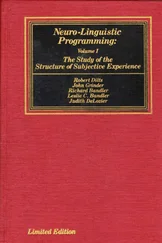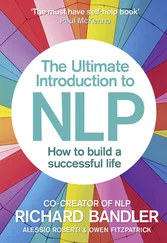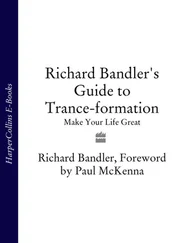The next time you do this exercise, I want you to begin by matching the person's present experience. Last time you described what would have to be there in some previous experience the person had. This time you'll begin by describing what has to be there in the person's experience now. So if I'm doing it with Charlie, 1 would say something like "And you are listening to the sound of my voice … and you can feel the warmth where your left hand is resting on your thigh… ."
There's an artistry to choosing these statements. "Until I say this sentence, you will be unaware of the temperature and feeling in your left ear" and suddenly you are aware of that. If I say to Ann "You can be aware of the feeling of warmth where your hand touches your chin" she was probably not aware of that before I made the statement. But when I said it, she could immediately verify that my verbalization was in fact an accurate representation of her experience. I come to gain credibility, and I also begin to amplify things that are true, but were unconscious in her before I mentioned them.
If I continue with kinesthetic statements and then say "And you can be aware of the sound of people shuffling paper in the room" she will again shift consciousness in order to determine whether my verbalization is accurate for her experience. I'm feeding back things that are a part of her experience, but are normally outside of awareness for her. So I'm building rapport, and at the same time I'm already altering her consciousness by that maneuver.
Today we're only going to explore the principles for inducing altred states. What you do to utilize an altered state after you get it is a separate topic, which we'll get to tomorrow.
For a long time hypnotists have worried about how "deep" you were. They used depth as an indication of what you could and could not do. AsfarasI can tell, depth is not a meaningful way to think about trance; in some altered states some hypnotic phenomena are possible, while others are not. But hypnotic phenomena per se are not that valuable. Being able to have positive or negative hallucinations is not something which is really that valuable in and of itself. Hallucinations can be used as tools to accomplish other ends, but they are not themselves that valuable. .
I have discovered that you can even teach people to do hypnotic phenomena—positive hallucinations, negative hallucinations, pain control, and so on—in the waking state. There is somebody in this room right now who can do these things in the waking state. Is there anybody here who can still see an imaginary friend or animal that you had as a child? Anybody? You can raise your hand, we won't arrest you. (Someone raises his hand.) OK, you can hallucinate in the waking state. That's a hallucination. I hope you realize that. If you don't, we have a psychiatrist waiting outside with an electric shock treatment machine.
There are many of you who can do negative hallucination; that is, you can look at somebody and not see them. Many of you have looked down at a table to try to find something on it, and you looked all over the place and didn't see it. Yet all that time it was lying right out in the open. That is not different from what people do in deep trances. Children negatively hallucinate their parents speaking to them all the time! How many of you can smell a rose when there isn't one? How many of you can take a deep breath and smell a rose right now? On a hypnotic chart that means you're three quarters of the way into the deepest trance you can be in! This either means that you've never been in the waking state, or that the people who make the charts don't know what they're talking about.
It's not a question of depth; if one of you in here were to experience the conscious state of the person sitting next to you for a moment, it would make LSD look trivial. Trance is only taking your conscious experience and altering it to something else.
In California the legislature is passing a law which says only licensed hypnotists can induce altered states. The ramifications of that particular law are going to be very interesting, because when people make love, they certainly induce altered states in one another. At least I hope making love is not the same as mowing the lawn! I'd like to know how they're going to enforce that law. Everybody's going to have to go out and become a licensed hypnotist so that they can get married.
Now back to your task. In addition to matching people's experience with your statements to get rapport, you need to be able to do something with the rapport you'll have. The key to this is being able to make transitions. You need to have a graceful way of guiding someone from his present state into a trance state—going from describing his present state to describing the state you want him to go to. Using transitional words allows you to do this smoothly. Transitional words such as "as" or "when" are words which imply that there is some meaningful relationship between two utterances. "As you sit there, it's possible for you to realize that I'm about to tell you something." There's no relationship between your sitting there and realizing something. However, it sounds meaningful, and it's the tone of voice and the transition "as" that imply meaning.
Beginning with sensory–based information allows you to make transitions and elicit responses that induce altered states. The sensory base for transitions needs to be something that the person with whom you are working can find. It doesn't need to be something he already has in awareness, but something that he can find. If I sit here and look down at Stan and say "Stan, you can feel the texture of your moustache and as you slide your finger, you can notice that you smiled and stopped. You can even feel your elbow with your other hand and sense the rise and fall of your own chest as you breathe. And you may not know it yet, but you're about to become aware of the temperature of your right foot."
Joe: I still don't understand what you mean by the term transition.
If I say to you "You asked a question while you were sitting in a chair" I am making a transition. I'm using the word "while" to define that two things are related. "You asked this" question because you want to know something that's important." Now most things aren't necessarily related, but using the word "because" gives them a relationship. i If I say "As you sit in that chair you are breathing in and out" it relates those two things by time. They are not necessarily related, but I relate them in time by saying "as."
I'm talking about relating the sentences by using transitional words. If I say to somebody "You're sitting in this chair. You are blinking your eyes. You are waiting," that doesn't have anywhere near the flowing quality of "You are sitting in the chair and you are blinking your eyes and you are wondering what the point of all of this is." Words like "and," "as," "while," "because," and "when" all build a relationship between parts of a sentence. The particular relationship is one of time That relationship allows people to move from one idea to another without disjunction. It's the same thing as saying "You're standing on the beach feeling the warmth of the sun on your body, and you look back at the beach as you take another stroke in the water." Even though the ideas aren't related, they become more related simply by adding those connecting words. You can take ideas that don't fit together and fit them together by gracefully using those kinds of words. When people listen to language, part of what allows them to flow from one idea to the other are these particular kinds of words. And you are here because you want to learn to be able to do a certain phenomenon called hypnosis. And as you go through the next three days, I'm going to teach you a lot of things that allow it to work easier. Why it works I don't know. But as you begin to try some of these things, you will find in your own experience that they have an impact. Even as I'm talking to you now, I'm using the same kinds of words and that's part of what makes it more meaningful.
Читать дальше











